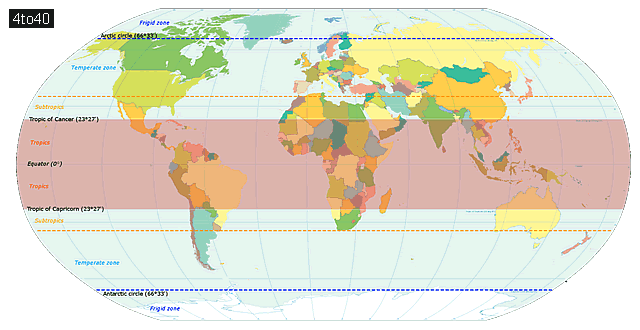International Day of the Tropics: It is observed on 29 June annually to spread awareness about the conservation strategies and to promote tropical regions on Earth. Let us have a look in detail at the history, theme, significance, and some facts.
International Day of the Tropics:
International Day of the Tropics: The day highlights unique challenges and opportunities that nations of the Tropics face and also provides an opportunity to take stock of progress across the tropics, acknowledge the diversity, and share tropical stories.
The tropics are the regions of Earth surrounding the Equator. They are defined in latitude by the Tropic of Cancer in the Northern Hemisphere at 23°26′10.0″ (or 23.43611°) N and the Tropic of Capricorn in the Southern Hemisphere at 23°26′10.0″ (or 23.43611°) S. The tropics are also referred to as the tropical zone and the torrid zone (see geographical zone).

History:
On 29 June 2014, the inaugural State of the Tropics Report was launched as the culmination of a collaboration between twelve leading tropical research institutions. The report provides a unique perspective on this increasingly important region.
The United Nations General Assembly adopted a resolution A/RES/70/267 in 2016, marking the anniversary of the report’s launch, and declared 29 June of every year to be observed as the International Day of the Tropics.
Theme:
Unlike other international days, there is no annual theme for each International Day of the Tropics. So, there is no particular theme for International Day of Tropics 2024.
International Day of the Tropics: Significance
The day was designated to spread awareness about the specific challenges faced by the tropical areas, implications of the issues affecting the tropical zone of the world, and the need at all levels to underline the important role that countries in the tropics will play in achieving the Sustainable Development Goals.
What are Tropics?
The roughly defined area between the Tropic of Cancer and the Tropic of Capricorn is the tropical region of the Earth. Topography and some other factors contribute to climatic variation. Also, tropical locations are typically warm and experience little seasonal change in day-to-day temperature.
A key feature of the Tropics is the prevalence of rain in the moist inner regions near the equator. The seasonality of rainfall increases with the distance from the equator.
Several challenges are faced by the tropical region like climate change, deforestation, logging, urbanization, and demographic changes.
Some facts about Tropics:
- The Tropics host about 95% of the world’s mangrove forest by area and 99% of mangrove species.
- Over half of the world’s renewable water resources (54%), Tropics have and almost half of their population are considered vulnerable to water stress.
- In the Tropics, biodiversity is greater, however, loss of biodiversity is also greater in the Tropics than in the rest of the world.
Facebook Banners, Posters, Header Covers
FAQs:
When was the inaugural State of the Tropics Report launched?
- The inaugural State of the Tropics Report was launched on 29 June 2014, as the culmination of a collaboration between twelve leading tropical research institutions.
What are Tropics?
- Roughly defined area between the Tropic of Cancer and the Tropic of Capricorn is known as Tropics.
What is the theme of the International Day of the Tropics?
- The theme of the International Day of the Tropics, according to the ‘State of the Tropics Report 2021’ is The Digital Divide in the Tropics.
When is International Day of the Tropics observed?
- International Day of the Tropics is observed on 29 June annually to spread awareness about the conservation strategies and to promote tropical regions on Earth.
 Kids Portal For Parents India Kids Network
Kids Portal For Parents India Kids Network









